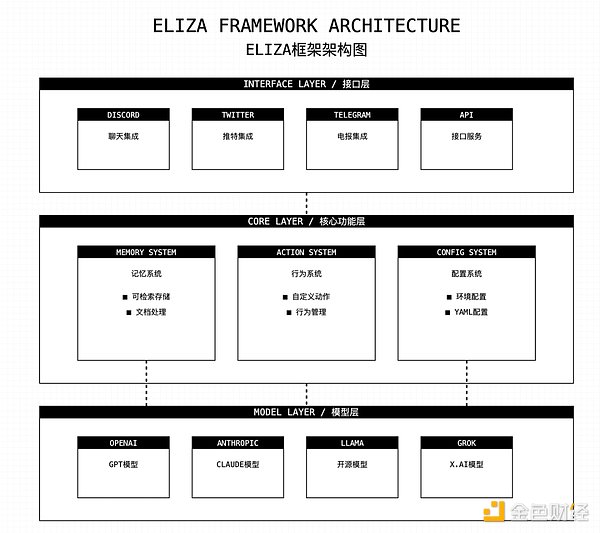
Author: Ningning
Spent some time studying the current version of AI16Z’s AI Agent framework Eliza. Differences from the V2 version revealed by Shawn.
Before comparing, let’s first understand the basic architecture of the current version and the V2 version.
As shown in Figure 1, the current version of Eliza framework consists of interface layer (Interface Layer), core function layer (Core Layer), and model layer (Model Layer) composition.
Interface Layer
Responsible for interaction with external platforms
Supports Discord, Twitter, Telegram and other platforms
Provides API interface for other systems to call
Core functional layer (Core Layer)
Memory system: Provides retrievable storage functions and document processing capabilities
Behavior System: Manage custom behaviors and action execution
Configuration system: Manage configuration through .env and elizaConfig.yaml
Model Layer
Supports multiple large language models, including OpenAI, Anthropic, Llama, Grok, etc.
Provides unified model interface abstraction
Each layer interacts through standard interfaces, supporting a high degree of modularity and scalability.
On the 15th, Shawn revealed that the Eliza v2 version is being developed and the alpha version is expected to be launched in 2 to 3 weeks.
Eliza v2 will unify the message bus and simplify the client; unify the Agent wallet; the model system adopts the registry and overlay mode; enhance the extensible common core framework; update the community plug-in; complete 100% Test coverage.
The architecture design diagram of the V2 version is as follows:
Let me explain the main improvements in Eliza v2 and their place in the architecture:
The interface layer Improvement: Unified Message Bus
Change the original scattered client integration into a unified message processing system
Each platform (Discord/Twitter, etc.) becomes an adapter for the message bus< /p>
Simplifies client development and maintenance
Provides a more consistent message processing experience
p>
Improvements in the core functional layer: unified proxy wallet
Integrate the original scattered wallet configuration
Provide unified multi-chain wallet management
Simplify cross-chain operations
Extensible core framework: Redesign the core interface to make it more versatile
Enhance the scalability of the framework
Better plug-in integration mechanism
Community plug-in update: improved plug-in system
Improve plug-in management
100% test coverage to ensure quality
Improvement of the model layer: Introducing the model registry mechanism
Supports dynamic registration and overwriting of models
Divide models into two categories: LLMs and Embeddings
More flexible model calling method
This new version of the architecture is more modular and unified, and the integration between different components The interaction is clearer and provides a better foundation for future expansion.
Finally, if analyzed from an investment perspective, Eliza v2 will be the best choice for AgentTank. Feature extensions bring new growth opportunities










